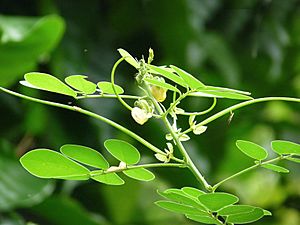Chinese senna facts for kids
Quick facts for kids Chinese senna |
|
|---|---|
 |
|
| Conservation status | |
| Scientific classification | |
| Genus: |
Senna
|
| Species: |
obtusifolia
|
| Synonyms | |
|
Numerous, see text |
|
Senna obtusifolia, often called sicklepod or Chinese senna, is a plant found all over the world. You can find it growing wild in North, Central, and South America, as well as in Asia, Africa, and Oceania. In many places, it's considered a serious weed. For a long time, people often confused it with another plant called Senna tora.
In traditional medicine, especially in Eastern Asia, the seeds of this plant are very important. They are known as pinyin: jué míng zǐ in Chinese, gyeolmyeongja in Korean, and ketsumeishi in Japanese.
The green leaves of Senna obtusifolia can be fermented to make a food called "kawal." This is a high-protein food eaten by many people in Sudan as a way to get protein instead of meat. The plant's leaves, seeds, and roots are also used in folk medicine, mostly in Asia. People believe it can help with digestion (like a laxative) and is good for the eyes. Often, the seeds are roasted and then boiled in water to make a tea.
The seeds of this plant are also used to make cassia gum, which is a food additive. It's often used to make foods thicker. This gum gets its name because Chinese Senna used to be in a different plant group called Cassia. If you roast and grind the seeds, they can even be used as a substitute for coffee! Scientists are also studying S. obtusifolia to see if it can be a source of useful natural chemicals for medicine.
Contents
What is Senna obtusifolia?
Senna obtusifolia has many common names. Besides "sicklepod," it's also called sickle-pod senna, Chinese senna, arsenic weed, foetid cassia, or wild senna.
Sometimes, people call it "coffee weed" or "java bean" (in Australia) or "coffee pod" (in the American South or West). However, these names can be confusing because they are also used for S. tora. In India, it might be called "chakunda," but this name is also used for S. tora.
The scientific name obtusifolia means "blunt-leaved." This comes from the Latin words obtusus (meaning "dull" or "blunt") and folium (meaning "leaf"). So, its scientific name describes its leaves!
Here are some names for the plant in its native regions:
- Chinese: jué míng zi (simplified Chinese: 决明子; traditional Chinese: 決明子)
- Japanese: ebisu-gusa (エビスグサ; 胡草; 恵比須草)
- Korean: gyeolmyeongja (hangul: 결명자)
- Vietnamese: quyết minh tử (from Hán tự: 決明子)
- Portuguese: fedegoso
- Hindi: chirauta chokad
Amazing Uses of This Plant
Traditional Medicine and Tea
The seeds of Senna obtusifolia are very important in Chinese traditional medicine, where they are called pinyin: jué míng zǐ. They are also known by the Korean name gyeolmyeongja and the Japanese name ketsumei-shi in traditional medicine.
This plant is widely used in Asia, including countries like Thailand. People often drink its herbal tea instead of regular tea. It is believed to help prevent high blood pressure. It is also thought to help clear and improve eyesight. In Korea, gyeolmyeongja is usually prepared as a tea called gyeolmyeongja-cha.
Another plant, Senna tora, is used in a similar way. Even though they are different, the Japanese government officially allows both S. obtusifolia and S. tora to be sold as ketsumeishi.
There's a Japanese drink called habu-cha. This tea was originally made from the seeds of a plant called habusō or S. occidentalis. But today, most habu-cha uses S. obtusifolia instead because it grows more easily and produces more seeds.
A Special Meat Substitute
In Sudan, people make a protein-rich food called Kawal. It's used as a meat substitute. To make it, the leaves of the Senna obtusifolia plant are crushed into a paste. This paste is then traditionally fermented in a special clay jar. The jar is buried in a cool place. Every three days, the jar is dug up, and the paste is mixed. After two weeks, the paste is taken out and rolled into balls. These balls are then left to dry in the sun. Kawal is usually cooked in stews with onions and okra.
See also
 In Spanish: Senna obtusifolia para niños
In Spanish: Senna obtusifolia para niños
Images for kids



